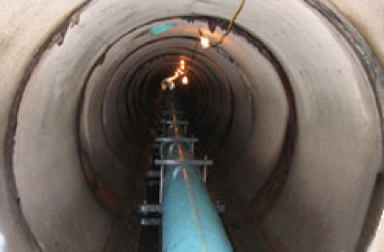About the Distribution and Collection System
Maintaining the 290 miles of water and sewer lines, all in a day’s work for the ten-man crew.
Services performed vary from routine meter reading and line inspection to repairing line breaks and responding to sewer backup problems. As the City grows, so does its water and sewer system. Approximately 146 miles of sanitary and storm sewer lines are cleaned and inspected every year.
Embracing new technology, the Board of Municipal Utilities retained Dr. Sim Sarikelle, a retired Professor of Civil Engineering at the University of Akron, to conduct periodic hydraulic analyses of Avon Lake’s water distribution system. A computer hydraulic model anticipates the demand for water on the system during average and peak periods and then determines adjustments in pressure required to assure an ample supply of water under all conditions of usage, including emergencies. The computer model can also record the frequency and location of water breaks and identifies those lines that need replacement.
It used to take six meter readers three weeks to manually read the city’s water meters. Now the task can be accomplished in three days using a Radio Transmitted Read (RTR) System. Currently all of the city’s water meters have been converted to the more efficient RTR.
Separating Avon Lake’s Combined Sewers

After passage of the Clean Water Act of 1972 (federal law), the City of Avon Lake and Avon Lake Municipal Utilities immediately began to separate its combined sewers and by 1974 had a City Master Sewer Plan in effect that would eliminate dry weather CSOs. By 1994 congress established a CSO Control Policy to provide guidance and authorize states to issue permits limiting the levels of overflow cities could discharge into the environment. It also ensured the public would be involved in the implementation of CSO management practices and controls.
In May of 2001, Avon Lake City Council authorized the City Engineer to begin requesting engineering service proposals for the design and construction of the Avon-Belden Road Combined Sewer Separation. The following March, the Municipal Utilities began negotiating a contract with Brown & Caldwell, a nationally recognized engineering firm specializing in CSO control planning, to develop a long term plan required by the State of Ohio EPA and USEPA.

Avon Lake’s Long Term Control Plan was introduced to the public at a meeting in the community library in January 2003. Designed to meet present requirements of the Clean Water Act, the plan will lessen future impact of overflows on the environment. It has a phased approach that considers the financial burden to the community. The plan is site-specific to Avon Lake, addressing the sensitive areas at Heider Ditch, the beach, and the water plant’s intake in Lake Erie. Alternative measures to sewer separation, such as storage/treatment, infiltration/inflow reduction, floatables control, and increasing treatment at Avon Lake’s Water Pollution Control Center (WPCC), are also being considered.
Sewer separation began in June 2003 on Moore Rd. Other areas of Avon Lake that Avon Lake Regional Water separated include Belmar, Moorewood, Mull-Norman, and Fairfield-Brookfield. In 2017, Avon Lake Regional Water in partnership with the City of Avon Lake began its last major combined sewer separation project, The 45 Area Combined Sewer Separation Project. This project is scheduled for completion in 2019.
d
